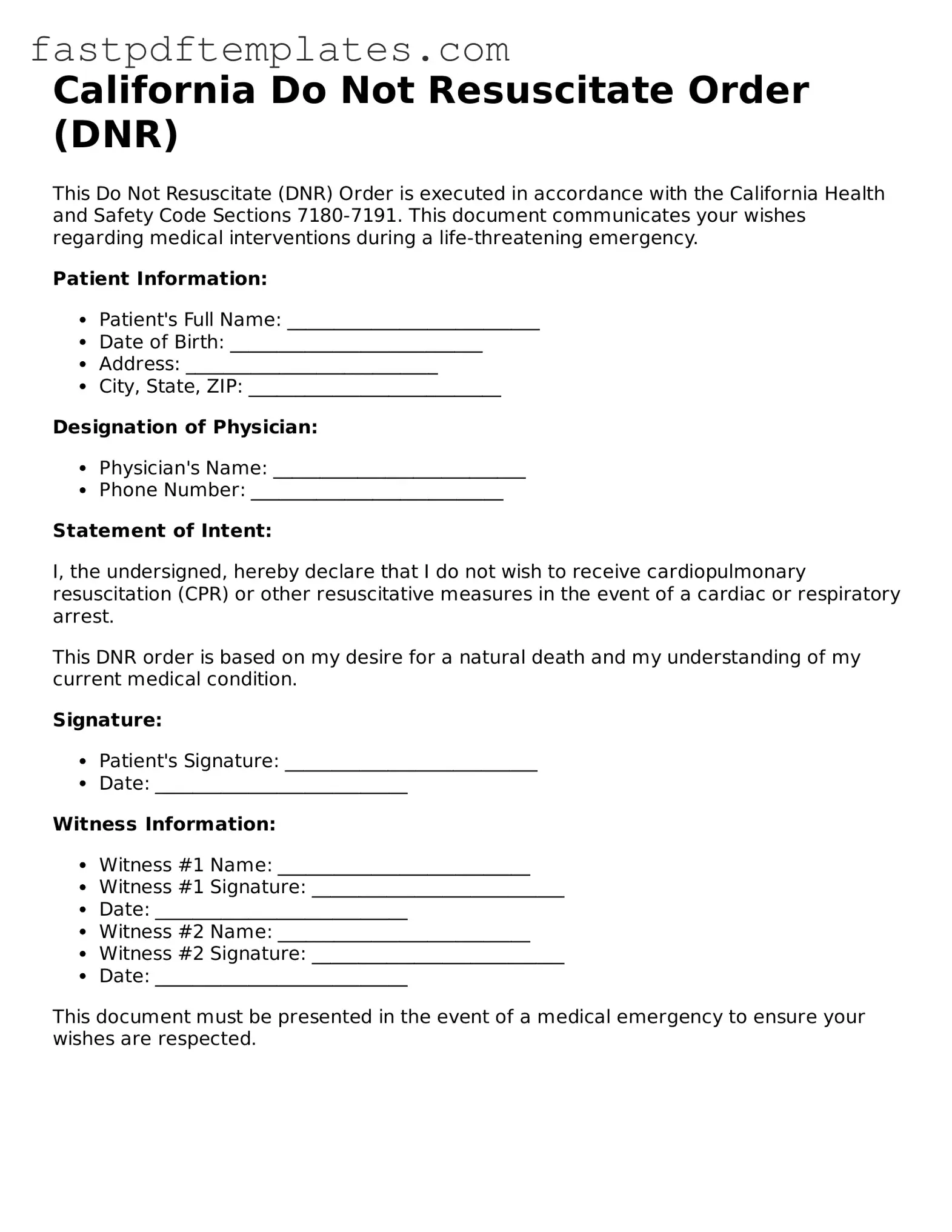The California Do Not Resuscitate (DNR) Order form shares similarities with the Advance Healthcare Directive. Both documents allow individuals to express their medical treatment preferences in advance. While the DNR specifically addresses resuscitation efforts in the event of cardiac or respiratory arrest, the Advance Healthcare Directive encompasses a broader range of medical decisions. This directive enables individuals to designate a healthcare agent and outline their wishes regarding various treatments, including life-sustaining measures, thereby providing comprehensive guidance to healthcare providers and loved ones.
Another document akin to the DNR is the Physician Orders for Life-Sustaining Treatment (POLST). The POLST form is designed for patients with serious illnesses or those nearing the end of life. Like the DNR, it communicates a patient’s wishes regarding resuscitation and other medical interventions. However, POLST goes further by detailing a range of treatment options, allowing for more nuanced decisions about care. Healthcare providers use POLST to ensure that patients receive treatment aligned with their preferences, making it a valuable tool for end-of-life care.
The Living Will is also comparable to the DNR Order. This document allows individuals to specify their wishes regarding medical treatment in situations where they are unable to communicate. While a DNR focuses on the specific action of resuscitation, a Living Will can cover a variety of medical scenarios, such as the use of artificial nutrition and hydration. Both documents serve the purpose of guiding healthcare providers and family members in respecting the individual’s choices during critical health situations.
Similar to the DNR is the Medical Power of Attorney. This document grants a designated person the authority to make healthcare decisions on behalf of the individual if they become incapacitated. While the DNR specifies what should not be done in terms of resuscitation, the Medical Power of Attorney empowers someone to make decisions, including those related to life-sustaining treatment. This relationship between the two documents ensures that an individual’s wishes are honored, whether through direct instruction or by delegating authority to a trusted person.
The Do Not Intubate (DNI) order is another related document. A DNI specifically addresses the individual’s wishes regarding intubation, a procedure used to assist with breathing during a medical emergency. Like the DNR, the DNI serves as a directive to healthcare providers, indicating that the patient does not wish to undergo this specific intervention. Both documents work together to clarify a patient’s preferences in critical care situations, ensuring that their choices are respected during emergencies.
Another relevant document is the Hospice Care Plan. This plan outlines the care and services a patient will receive as they approach the end of life. While the DNR focuses on resuscitation efforts, the Hospice Care Plan encompasses a holistic approach to comfort and quality of life. It includes pain management and emotional support, ensuring that the patient’s needs are met in a compassionate manner. Both documents emphasize the importance of respecting the patient’s wishes in end-of-life care.
The Comfort Care Order is similar to the DNR in that it prioritizes the patient’s comfort during serious illness. This order indicates that the patient should receive palliative care aimed at alleviating pain and discomfort rather than aggressive life-saving measures. While the DNR specifically addresses resuscitation, the Comfort Care Order provides a broader framework for ensuring that the patient’s quality of life is maintained, reflecting their values and preferences.
The End-of-Life Care Plan is another document that aligns with the DNR. This plan encompasses a comprehensive approach to the patient’s care as they approach the end of life. It includes preferences for treatment, pain management, and emotional support. Like the DNR, the End-of-Life Care Plan aims to ensure that healthcare providers understand and respect the individual’s wishes, facilitating a dignified and compassionate approach to care.
Finally, the Do Not Hospitalize (DNH) order is related to the DNR in that it expresses a patient’s desire to avoid hospitalization in certain situations. While the DNR focuses on resuscitation efforts, the DNH order indicates that a patient prefers to remain at home or in a comfortable setting rather than being admitted to a hospital. Both documents emphasize the importance of honoring the individual’s preferences in medical care, particularly during critical times.
